A postcard from Davenport, No.2
To the Davenport History menu
From time to time
postcards of Davenport become available on eBay and
elsewhere, opening a window into the past: here is a selection which we
hope is of interest, with special thanks to Peter Wadsworth for access
to his collection.
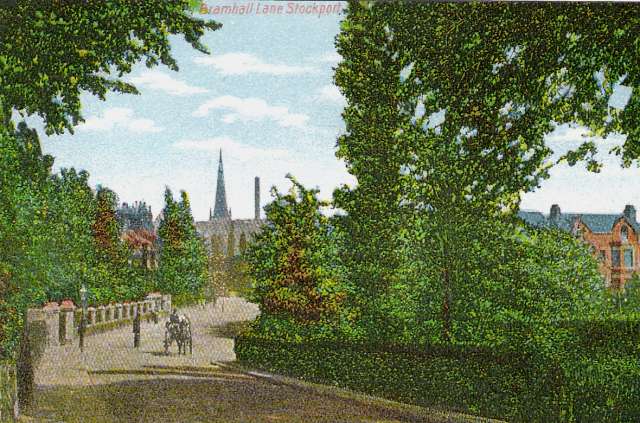
This Edwardian coloured postcard looks down Bramhall Lane from
Davenport station bridge towards Stockport, probably around 1905. A
horse and cart makes up the only road traffic in view. The white fence
to the left and the two gates were the frontage of 'Bramall Mount'
which in 1901 was the home of Samuel Rigby, an unmarried cotton waste
merchant (born 29 May 1846) , and his two servants Sarah Wakefield and
Mary Grocott. Mr Rigby was a prominent local citizen, serving as a
Stockport Borough Magistrate from 1900 to 1904. He later retired to
'The Pines' in Harrogate where he died on 10 March 1935, and his body
was
brought back to Stockport to be buried in Stockport Cemetery - his
grave is pictured on the Carl's Cam website.
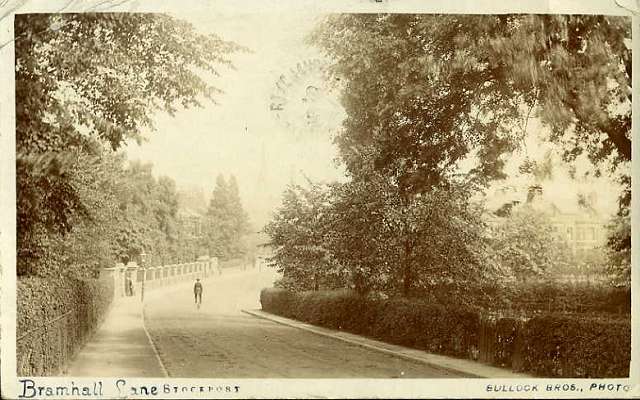
A locally-produced postcard showing the same scene from about the same
time. Is that a 'penny-farthing bicycle? The photographers, Bullock
Brothers,
operated from premises at 108 Wellington Road South, and
later 26 Greek Street, Stockport. (See our Bullock
Brothers article)
Samuel Rigby was the son, and inheritor of the house and business of,
James
Webster Rigby. The 1861 census shows James Webster Rigby, a native of
Stockport who in 1851 had
lived on Longshut Lane, living at Bramall Mount with his wife
Sarah, children James, Mary and Samuel, and their domestic servant
Salina Jane Moore.
Bramall Mount (note the old spelling without the 'h') is built on land
purchased by James Webster Rigby and John Rigby from Lady Maria
Davenport in September 1851, before the railway came, making it one of
the
first houses to be built in Davenport. until 1901 the boundary between
Bramhall township and Stockport ran along Kennerley Road and crossed
this picture just past the end of Bramall Mount's fence. The 1910
Stockport directory shows Samuel Rigby & Co operating from Spring
Bank Mill, on Wellington Road adjacent to Edgeley station.
Bramall Mount was bought by Stockport Corporation after Samuel Rigby
retired, some time after 1910. A large part of its grounds were
added to Cale Green Park, which had opened in 1902. The
house became the official residence of the Corporation's Parks
Superintendent. Later, houses were built on remaining land to the rear,
and the house itself has been divided into flats.
Conspicuous on the skyline are the tall spire of the then-new St
George's Church, built in 1897, and the roof and chimney of Ephraim
Hallam's cotton mill. The houses on Kennerley Road can be seen, but the
large detached house at the end of Devonshire Park Road had not yet
been built.
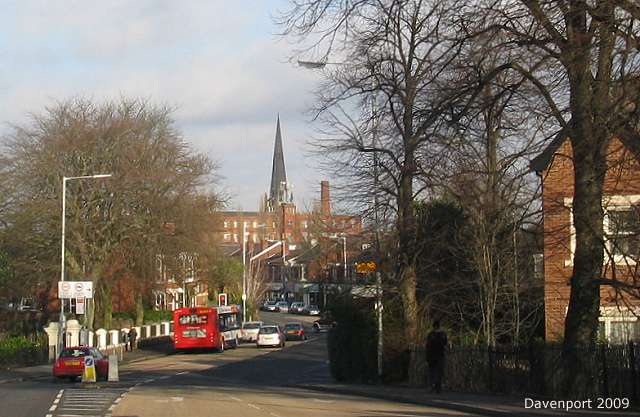
An attempt to match the same scene in 2009 - taken in a brief
pause while crossing the road at the station traffic lights. The road
has been greatly widened at this point, once in the 1930s and again in
1980, by building new and extended versions of the station bridge. The
church and the mill continue to appear on the horizon, although the
mill
chimney
has been shortened. Hallam Mill, also known as Heaviley Mill, was
apparently built sometime around 1860, and for many years was operated
as a cotton waste spinning mill by Ephraim Hallam, who served as Mayor
of Stockport in 1872 and presented the town with the small park and row
of almshouses near the mill. He died in 1897, and the mill became the
Squirrel Confectionery works, and as such was familiar to many. The
company moved away in 1968, and since then it has housed a number of
small businesses. The house on the right, dating possibly from 1920s,
became part of Oriel Bank School, a private school which had been
founded in 1887 and been housed in various places on Bramhall Lane,
eventually expanding into this, and six other houses at this and of
Devonshire Park Road. The school closed down in 2005, and all the
houses were bought by Paul Cook Developments and converted back to
residences.
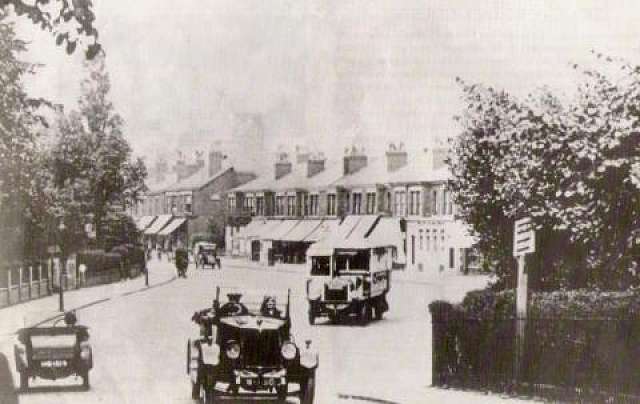
This picture from our collection dates from the 1920s. The bus is, we
believe, one of the Tilling-Stevens vehicles bought by the North
Western Road Car Company in 1925. North Western, formed in 1923, was a
subsidiary of the British Electric Traction company, formed to operate
its Stockport - Bramhall - Wilmslow services and other local routes.
This one has a long history; later numbered 78 by North Western, it
became Greater Manchester Transport's 378 when 300 was added to
Stockport Corporation and North Western's numbers in the area to
distinguish them from those taken other from other Greater Manchester
operators. In 2009, Stagecoach Manchester operates (more or less)
the same route, still numbered 378.
From 1928, Davenport was also served by Stockport Corporation buses
running between Stockport and Woodsmoor, initially turning back at the
junction of Bramhall Lane and Woodsmoor Lane, and extended after
World War II to Crossway - forerunner of the 372
service.
All the houses on the east side of Bramhall Lane became shops and
business premises soon after they were built. Note the standardised
portland stone facing applied to Williams Deacon's Bank branch, 231
Bramhall Lane, still evident today in its guise as the Royal Bank of
Scotland. This was one of the later houses to be converted: the 1910
directory shows it as the home of a Mrs Miller.
The sign on the right appears to be directing passengers to the station.
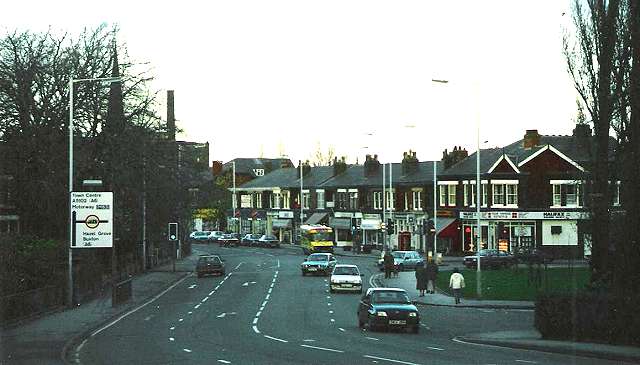
This view, already historic, dates from about 1987: note the yellow
minibus of the short-lived Bee Line Bus Company, which was a subsidiary
of the very same British Electric Traction Company mentioned in the
caption above, and attempted to revolutionise the world of buses after
the 'deregulation' of services in 1986; for a short while their
competition with 'GM Buses' on the Woodsmoor route became quite absurd.
Another sign of the times is the Royal Bank of Scotland logo on the
bank; Williams Deacon's, later Williams & Glyn's, bank had
actually been owned by the Royal Bank of Scotland since 1930, but
became fully integrated in 1985. Four Yards Estates, on the
corner of Kennerley Road at 235 Bramhall Lane, was the main
estate agent in Davenport at the time, later taken over by various
groups, and in 2008 closed down, to be converted to a hairdressing
salon.
Written by Charlie Hulme, 2009.
Updated October 2011.
Comments welcome at info@davenportstation.org.uk
|
|